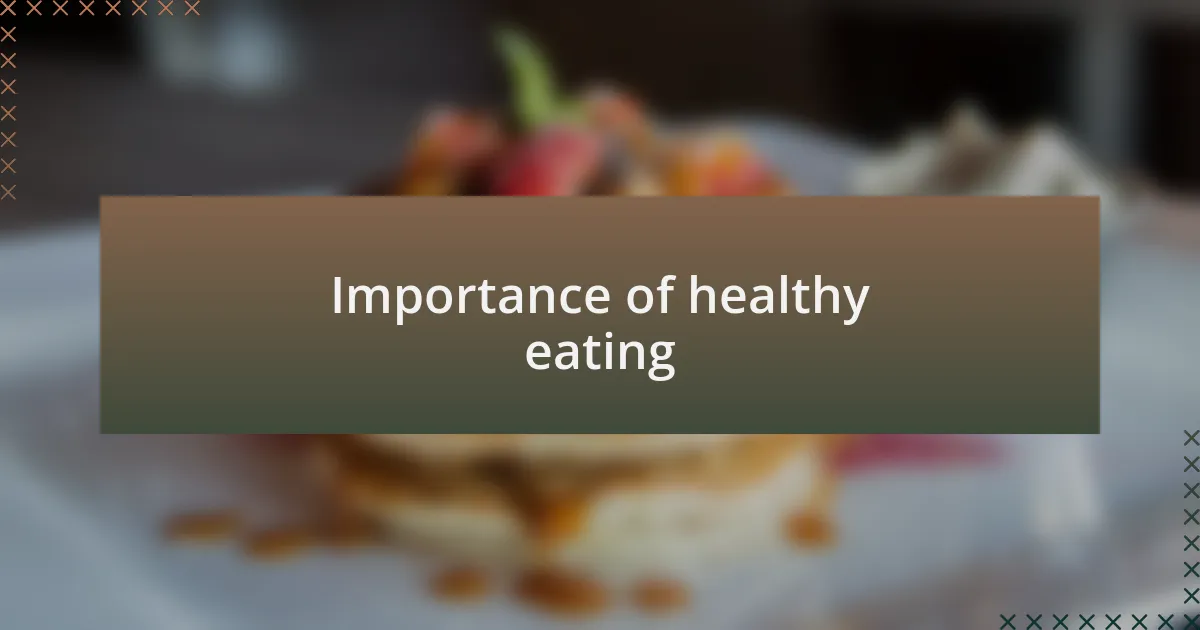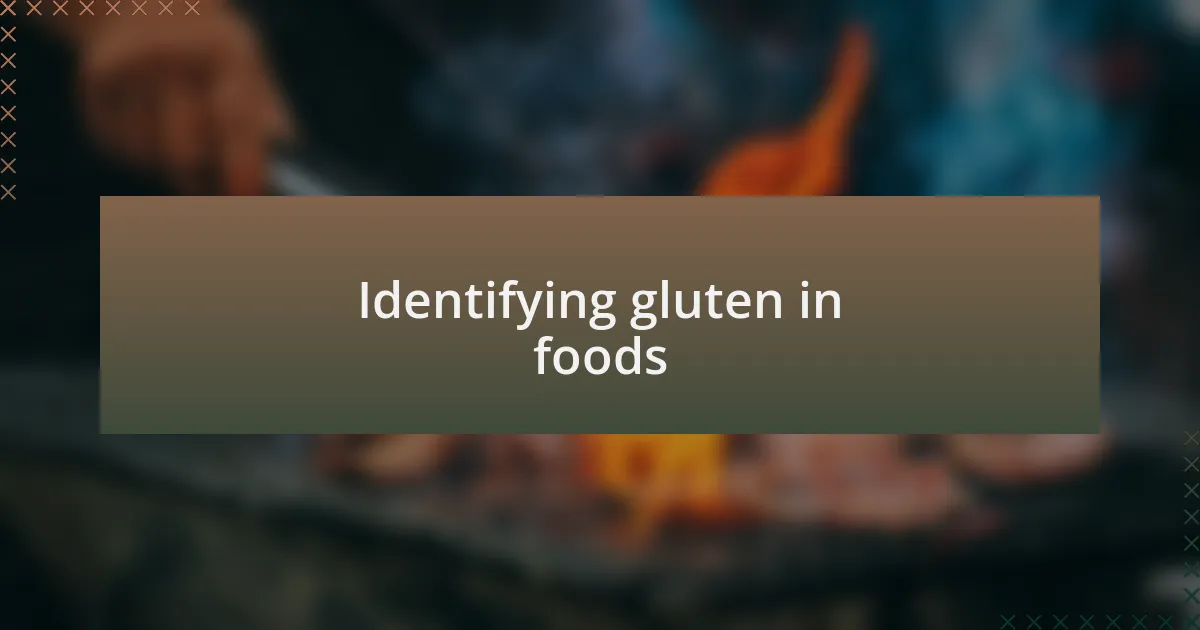Key takeaways:
- Celiac disease is an autoimmune disorder triggered by gluten, requiring a strict gluten-free lifestyle.
- Healthy eating is essential for repairing the small intestine and overall health; it empowers individuals managing the condition.
- Identifying gluten in foods necessitates careful label scrutiny and proactive inquiries when dining out.
- Meal planning and batch-cooking can simplify gluten-free living, offering convenience and reducing stress.

Understanding celiac disease
Celiac disease is an autoimmune disorder where the ingestion of gluten—a protein found in wheat, barley, and rye—triggers a damaging immune response in the small intestine. I still remember the sense of relief when I first learned that my persistent digestive issues were tied to celiac disease rather than being a figment of my imagination. Can you imagine the confusion and frustration of not knowing what was making you feel so unwell?
Living with celiac disease means adopting a strict gluten-free lifestyle, which can feel overwhelming at first. Initially, I found myself staring blankly at grocery aisles, puzzling over labels, and wondering how I would ever dine out again. It’s both a challenge and a journey; when you think about it, how often do we take the foods we enjoy for granted?
The emotional impact of navigating this disease can be immense. I’ve encountered feelings of isolation, especially when friends indulged in gluten-rich meals without a second thought. Do you ever feel that weight of not fitting in at social gatherings? It’s a real challenge, but understanding celiac disease has also led me to discover a vibrant community and explore a plethora of delicious gluten-free options that I never knew existed.

Importance of healthy eating
Eating healthy is crucial, especially for those managing celiac disease. A balanced diet can help in repairing the damage to the small intestine and restoring overall health. When I shifted my focus to whole, nutrient-rich foods, I noticed a significant boost in my energy levels—not something I expected at all!
Choosing the right foods goes beyond just avoiding gluten; it’s about fueling our bodies with the vitamins and minerals they need. Incorporating fresh fruits, vegetables, lean proteins, and gluten-free grains made me feel more connected to my meals. Have you ever experienced the joy of preparing a colorful salad or a hearty quinoa bowl? It’s an experience that not only satisfies your taste buds but also nourishes your body.
Healthy eating is also an essential act of self-care. I remember the early days of my diagnosis when I felt deprived and limited. But now, each meal is an opportunity to reclaim my health. The satisfaction of consciously selecting foods that benefit my body makes every bite feel empowering. Isn’t it amazing how what you eat can profoundly impact how you feel?

Identifying gluten in foods
Identifying gluten in foods can be quite the challenge, especially when you’re first navigating the world of gluten-free eating. I still recall a trip to the grocery store when I realized that even simple condiments like soy sauce can contain hidden gluten. It’s essential to scrutinize labels carefully—any food that doesn’t directly state “gluten-free” often raises a red flag in my mind.
As I’ve learned, gluten can hide under various names, such as wheat, barley, and rye. This discovery changed how I approached food labels. I often find myself asking, “Could this seemingly innocent snack be harboring gluten?” It’s a constant reminder that vigilance is key, and I’ve made it a habit to keep a list of common gluten-containing ingredients handy for quick reference when shopping.
Another tip that has served me well is learning to ask questions when dining out. I can’t count the number of times a simple inquiry about gluten-free options opened a dialogue with a chef who was eager to accommodate my needs. This has turned dining out from a stressful experience into one filled with exploration and new flavors. How about you? Have you found that being proactive in restaurants leads to discovering delightful dishes?

Grocery shopping tips for celiac
When I hit the grocery store, I always start from the perimeter where the fresh produce and meats are located. I remember the first time I discovered that a tempting pre-packaged salad could come with a dressing containing gluten. Now, I always keep my eyes peeled for fresh ingredients, focusing on whole foods instead of processed items whenever possible. Have you noticed how much better you feel when you avoid the aisles filled with gluten-laden snacks?
Another strategy I’ve developed is to familiarize myself with brands that cater specifically to gluten-free diets. I felt like I hit the jackpot the day I stumbled upon a gluten-free bread that didn’t taste like cardboard! Trusting specific companies can significantly ease the shopping experience, helping me find safe snacks and staples that I genuinely enjoy. How satisfying is it to discover products that fit our dietary needs without sacrificing flavor?
Lastly, I always make a detailed shopping list before heading out, including a checklist of gluten-free staples and alternatives. This practice not only saves me time but also keeps me focused and minimizes impulse buys that could lead to gluten mishaps. I still chuckle when I think about how a quick trip for rice turned into an accidental purchase of a gluten-laden sauce. Isn’t it empowering to take charge of our grocery choices?

Meal planning for celiac diet
Meal planning for a celiac diet can feel daunting, but I find that having a weekly framework really simplifies things. Each Sunday, I sit down with my favorite gluten-free cookbooks and pick recipes that catch my eye. I feel a sense of excitement as I envision flavorful meals like quinoa bowls or zucchini noodles, and it transforms a tiring chore into something enjoyable. Have you ever felt a rush of inspiration while planning your meals?
Once I’ve selected my recipes, I create a list of ingredients, making sure everything is gluten-free. I remember one week when I forgot to include gluten-free soy sauce for my stir-fry; what a disaster that turned out to be! Now, I double-check my pantry and fridge before heading to the store. It’s amazing how much smoother the cooking process goes when I know I have everything on hand, reducing the risk of last-minute scrambles.
On days when cooking feels overwhelming, I batch-cook gluten-free meals in advance. I often find solace in preparing a large batch of chili or soup, which I can freeze and enjoy later. Knowing that nutritious meals are just a reheating away brings me peace of mind, especially on busy days. Have you tried batch-cooking? It really can save you time and stress.

Cooking tips for gluten-free meals
Cooking gluten-free meals requires a bit of creativity and awareness. I remember the first time I experimented with gluten-free flours; I was pleasantly surprised by the unique flavors and textures they brought to my dishes. Have you ever thought about how substituting just one ingredient can completely change a meal? Using almond flour or coconut flour can add a delightful twist to pancakes or breading, making them not only gluten-free but also incredibly tasty.
When it comes to gluten-free pasta, I always keep a selection of alternative grains like brown rice or chickpea pasta in my pantry. One evening, I prepared a spaghetti dish using spiralized zucchini instead of traditional noodles. The result was a refreshing take that I absolutely loved. It’s moments like these that keep cooking exciting—why not play around with different vegetables and grains to find your perfect match?
Lastly, I’ve found that cross-contamination is a sneaky enemy in the kitchen. One day, after making a delicious stir-fry, I realized I had used the same cutting board as my gluten-containing bread. That didn’t sit well with me! Now, I make it a habit to designate specific utensils and spaces for gluten-free cooking. Have you established a cooling method in your kitchen to keep things safe? It truly makes a difference in feeling confident about what you’re eating.

Personal experiences with managing celiac
Managing celiac disease is a journey I never anticipated, but it has taught me so much about resilience. I still remember the frustration of dining out once, where the server assured me the dish was gluten-free, only to later discover traces of gluten in the sauce. That moment made me realize just how vigilant I needed to be—what’s your strategy when eating out to ensure safety?
Over time, I’ve built a network of supportive friends who understand my dietary restrictions. One friend even went out of her way to research gluten-free recipes for a dinner party we hosted. The heartfelt gesture made me feel accepted and included, which reminded me how crucial it is to communicate my needs. How do you share your dietary preferences with others?
I’ve embraced my condition by exploring new foods and flavors, which has opened doors I didn’t expect. I fondly recall discovering a local farmers’ market, where I found fresh, organic ingredients that became the cornerstone of my meals. This experience allowed me to appreciate the vibrant diversity of foods available to me—have you explored any new options that excited your palate?